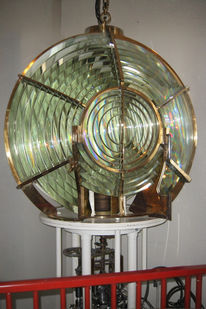Marblehead Lighthouse
Shipping on the Great Lakes had been steadily increasing in volume since the discovery of the lakes by French trappers between 1615 and 1669. After the Revolutionary War, the fledgling United States needed revenue. One of the few taxes available to the government was tariffs on trade goods. In order to foster trade, Congress, in its ninth official law passed the Lighthouse Act to construct lighthouses. Ohio became the 17th state in 1803, and Commodore Oliver Hazzard Perry defeated a British fleet in the Battle of Lake Erie in 1813, gaining possession of large portions of the Great Lakes for the United States.
In 1819, the fifteenth U.S. Congress recognized the need for lighthouses on the Great Lakes to guide mariners by day or night. They authorized $5,000 that year and another $5,000 the following year, for the construction of a lighthouse to mark the entrance to Sandusky Bay, the safest harbor between Cleveland and Toledo on Lake Erie. The fifty-five-foot tower of the light was completed in November of 1821 by Sandusky’s first stonemason, William Kelly, and six assistants, using locally-quarried limestone. The tower was set on bedrock, with no man-made underpinnings. It was located on three acres of what the locals called Rocky Point, a small peninsula on the larger Danbury peninsula which was part of the Firelands given to Danbury CT residents. The name Marble Head (two words) did not come into use until around 1840, so the lighthouse was called the Sandusky Bay Lighthouse until 1870 when it was renamed the Marblehead Lighthouse.
The top and inside of the lighthouse were completed in 1822. A light source, comprised of 13 lanterns with 16” polished brass reflectors fueled by whale oil, beamed a fixed white light. Kelly also built a stone lighthouse keeper’s dwelling on the property next to the lighthouse. Revolutionary War Veteran, Benajah Wolcott was appointed the first Keeper by President James Monroe in June and the light was finally lit. Wolcott also had his own private residence on his 114-acre farm about 3 miles from the light.
As whale oil became scarcer and more expensive, a series of other fuels were employed by the Lighthouse Service, including lard oil and eventually kerosene. By 1858 the light at Marblehead had been changed to a single pressurized kerosene lamp with a 4th order glass Fresnel lens to intensify the lamp's brightness out on the lake. This lantern consumed much less fuel each night and further increased the visibility of the lighthouse.
By the 1890’s the ships on the Great Lakes were getting larger and required deeper water. This forced shipping further from the shoreline and the lighthouse needed to shine brighter and farther. To accomplish this, an addition to the height of the tower and a larger lens for the light source were planned. The larger lens would require a larger lantern (the windows the light shines through), a matching dome on top and larger deck around the lantern. The problem was if the tower were made taller, the conical shape of the tower would end up being too narrow to support the changes. So, in 1897, over eight feet of stone was removed from the top of the tower and a circular brick liner was built inside the tower from the base, back up to its original height. This made the top of the tower larger in circumference than it had been originally. In 1898, a spiral iron staircase was attached to this liner, replacing the wooden steps. In 1900, nearly seven more feet of height was added to the brick liner, keeping the larger circumference intact.
In 1901, a ten-ton, ten-sided lantern replaced the old eight-sided lantern. The lantern was reused from the decommissioned Erie Land Light in Pennsylvania. A new observation deck and a second, smaller walkway deck was added around the new lantern to facilitate cleaning the windows. With the addition to height, the new lantern, including dome with ventilator ball and lightning rod, raised the height of the lighthouse to 77 feet 8 1/8 inches tall. In 1903, the new 3 ½ order Fresnel lens from Paris, France was installed along with a clockwork mechanism to rotate the lens to make the light appear to flash every 10 seconds. This beautiful glass prismatic lens is now on display in the Keeper’s House Museum adjacent to the lighthouse. In 1923, the kerosene-fueled lamps were replaced by electric bulbs making the light go from 42,000 candlepower to 350,000. Today the light source is supplied by high-intensity green LED lights that were installed in 2013, and they flash once every 6 seconds. In 1958, the entire mechanism was automated so it turns on at dusk and off at dawn. Thus, the need for on-site lightkeepers was over.
In 1939, with war in Europe looking likely, President Roosevelt's Reorganization Order #11 disbanded the U.S. Lighthouse Service and gave operation of all aids to navigation, to include lighthouses, to the U.S. Coast Guard. The Coast Guard is the “keeper of record” of all U.S. lighthouses to this day.







